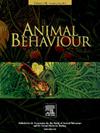狗、示威者和弯路:障碍物的形状重要吗?
IF 2.3
2区 生物学
Q2 BEHAVIORAL SCIENCES
引用次数: 0
摘要
绕过透明的障碍物对狗来说是个挑战;然而,从人类演示者那里进行社会学习可以使这项任务变得更容易。在众多影响因素中,障碍物配置对狗狗绕行性能的影响尚未得到研究。我们预测,狗会更容易绕过一个笔直的障碍物,比如篱笆,而不是一个有角度的障碍物,因为在笔直的情况下,它们会更容易注意到栅栏的远端。我们测试了N = 84只伴侣犬,分为四组:直线和v形围栏,有和没有示范。每只狗必须连续进行三次试验。在示范组中,实验人员在试验2和3之前向狗展示了解决方案。我们发现,在这两种情况下,狗的绕路潜伏期只有在观察到示范时才会有所改善。不管示范如何,狗更成功,绕着直的篱笆绕得更快。在直栅栏/控制条件下,狗的成功率表现出天花板效应。这些结果表明,障碍物的空间布局会影响狗狗绕行的难度。当他们能够更容易地看到障碍的边界时,无论是因为更宽的可见角度,还是因为起点和直栅栏末端之间的距离更短,这可能会更有效地抑制(徒劳的)直接尝试获得障碍后面的奖励,从而导致更高的成功率。我们可以假设,当狗狗向演示者学习时,它们可能依赖于反应促进而不是刺激增强,因为它们在两种障碍配置之间的社会学习成功没有表现出任何差异。我们的发现为如何利用障碍物的空间布局来潜在地解开狗在运动绕行任务中的社会学习机制提供了新的见解。本文章由计算机程序翻译,如有差异,请以英文原文为准。
Dogs, demonstrators and detours: does the shape of the obstacle matter?
Making a detour around a transparent obstacle poses a challenge for dogs; however, social learning from a human demonstrator can make the task easier. From among many influencing factors, the effect of obstacle configuration on dogs' detour performance has not yet been investigated. We predicted that dogs would more easily detour around a straight obstacle, such as a fence, than an angulated one, because they would notice more easily the far end of the fence in the case of the straight configuration. We tested N = 84 companion dogs in four groups: straight and V-shaped fence, with and without demonstration. Each dog had to perform three consecutive trials. In the demonstration groups, the experimenter showed the dogs the solution before trials 2 and 3. We found that the dogs' detour latencies improved in both conditions only when they observed a demonstration. Irrespective of the demonstration, dogs were more successful and made a faster detour around the straight fence. In the case of the straight fence/control condition, dogs’ success rate showed a ceiling effect. These results imply that the spatial arrangement of an obstacle can affect the difficulty level of a detour for dogs. When they were able to see the boundaries of the obstacle more easily, either because of the wider angle of visibility or the shorter distance between the start point and the ends of the straight fence, this may have been more effective in inhibiting (futile) direct attempts to obtain the reward behind the obstacle, therefore resulting in higher success. We can assume that dogs may rely on response facilitation rather than stimulus enhancement when they learn from the demonstrator, as they did not show any differences in their social learning success between the two obstacle configurations. Our findings provide new insight on how the spatial layout of an obstacle can be used to potentially disentangle the social learning mechanisms in dogs during a locomotory detour task.
求助全文
通过发布文献求助,成功后即可免费获取论文全文。
去求助
来源期刊

Animal Behaviour
生物-动物学
CiteScore
4.60
自引率
8.00%
发文量
236
审稿时长
10.2 weeks
期刊介绍:
Growing interest in behavioural biology and the international reputation of Animal Behaviour prompted an expansion to monthly publication in 1989. Animal Behaviour continues to be the journal of choice for biologists, ethologists, psychologists, physiologists, and veterinarians with an interest in the subject.
 求助内容:
求助内容: 应助结果提醒方式:
应助结果提醒方式:


